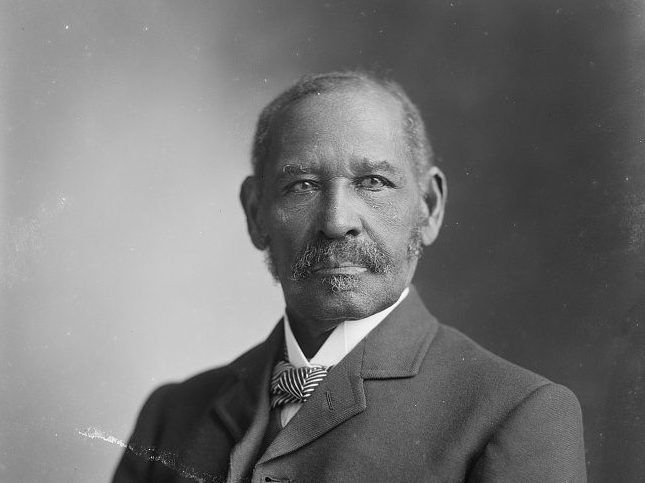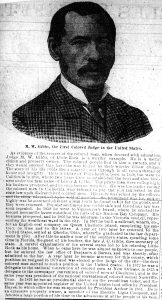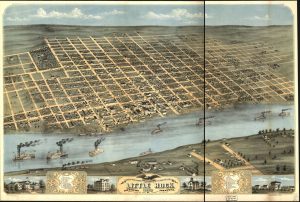Why should we remember Mifflin Gibbs?
Subject(s): African Americans, Arkansas History, Civics & Government, US History, and Biography
Time Period(s): (1850-1877) Civil War and Reconstruction, (1870-1900) Development of The Industrial United States, and (1890-1930) Emergence of Modern America
Grade level(s): 3-5, 6-8, and 9-12
Click here to download the powerpoint
One of Little Rock’s most influential politicians in the late 19th and early 20th centuries, Judge Mifflin Wistar Gibbs was born a free black in Philadelphia in 1823. A successful entrepreneur, he lived in Philadelphia, San Francisco, British Columbia, and Oberlin, Ohio, before settling in Little Rock in 1871. In 1873 he was elected the country’s first African American judge. He was a prominent figure local, state and national Republican politics, a friend of Frederick Douglass and Booker T. Washington. His daughters Ida Gibbs Hunt and Harriett Gibbs Marshall were published authors and educators. Gibbs received presidential appointments to the positions of register of the U.S. land office and receiver of public monies in Arkansas, as well as U.S. consul to Madagascar. He died in 1915 in his house at 1518 Chester Street and is buried at Oakland Fraternal Cemetery.
Supporting question(s):
Who was Mifflin Gibbs?
Where did he live and travel? Why?
What rights and responsibilities did Mifflin Gibbs have, as an African American man living in the United States between 1823 and 1915? How did these change over his lifetime?
What contributions did Mifflin Gibbs make to Little Rock, Arkansas, and the United States?
Source Set
- Portrait of Judge M. W. Gibbs
- M.W. Gibbs Called By Death
- M.W. Gibbs, the First Colored Judge in the United States
- Bird’s eye view of the city of Little Rock, the capitol of Arkansas 1871
- “Public Buildings -- The Custom House and Post Office”
- The Poll-tax vs Colored Men
Description
This obituary appeared in the Little Rock newspaper, Arkansas Gazette, on July 12, 1915, on page 5.
Description
This article describes Mifflin Gibbs’s contributions to Little Rock and Arkansas, and his biography up to 1885.
Description
Color map of Little Rock from 1871 showing an aerial view of the Arkansas River, street grid, and downtown buildings, looking southwest.
Description
Excerpt of a city guidebook on Little Rock, 1890, about public buildings in the city, including the Post Office Building where Mifflin Gibbs worked.
Description
1857 Letter to the editor (William Lloyd Garrison) from Peter Lester & Mifflin Gibbs regarding the poll tax, which African American men had to pay, even though they could not vote in California.
Additional resource(s):
Prezi: Traveling the World with Mifflin W. Gibbs
Encyclopedia of Arkansas: Mifflin Wistar Gibbs
Arkansas Black Lawyers: Mifflin Gibbs
National Humanities Center: Excerpts from Shadow and Light, Gibbs’s 1902 autobiography (illustrated)
E-book: Shadow and Light (Google Books)
Arkansas Frameworks(s):
Grade 3 Social Studies
C.2.3.3 Compare rights and responsibilities of citizens in different times and places
H.12.3.4 Analyze individuals, groups, and events to understand why their contributions are important to historical change and/or continuity
Arkansas History grades 7-8
E.3.AH.7-8.4 Examine contributions of Arkansas entrepreneurs on economic development in Arkansas
H.7.AH.7-8.4 Examine effects of Reconstruction in Arkansas using multiple, relevant historical sources (e.g., Brooks-Baxter War, Constitution 1874, Freedmen’s Bureau, sharecropping, segregation laws)
H.7.AH.7-8.11 Construct historical arguments about the contributions made by various political and military leaders in Arkansas
Civics
PD.3.C.1 Evaluate the rights and responsibilities of citizens in the United States
PD.3.C.3 Construct explanations of the ways citizenship in the United States has changed over time and been affected by public policy, geographic location, state and federal law, and demographics using a variety of sources






